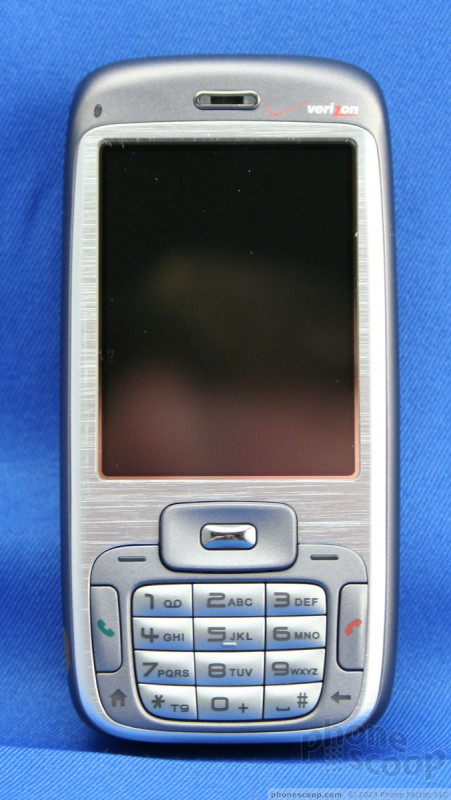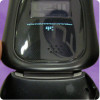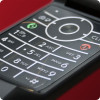Review: HTC SMT-5800
HTC is not known to make small smartphones. The bulk of its lineup is actually quite beefy. The SMT-5800 may slim things down a bit for a more pocket-friendly device, but it sacrifices usability to do so.
The 5800 achieves it size reduction by tightening the belt around its mid-section. It is narrower from side to side than some models from HTC, such as the XV6800, though it is about the same thickness from front to back. On the front of the 5800 is a screen with common QVGA resolution, navigation cluster and numeric keypad below it. It's obvious that the 5800's designers wanted to maximize the screen size on the front, and the usability of the nav cluster and keypad suffer greatly as a result.
The D-pad itself is wide enough for side-to-side navigation, but it is very short from top to bottom. It also has a high edge that really makes it stand out from the surface of the phone. The center button is very bubble-like. It really feels tall and pointy when your thumb presses it. This combined with the small-ish D-pad make for an unpleasant experience. The fat-fingered are going to have issues using the D-pad.
Each soft key is flush with the phone's surface and has a small strip of plastic that helps your thumb find it. Because of the high edge of the D-pad, using thesoft keys to its left and right is challenging. I often found myself accidentally hitting the corner of the D-pad when trying to use eithersoft key, which messed up my attempts to activate the feature I wanted to use.
Another issue worth pointing out is that the upper left and right corners of the D-pad are directly below the "Start" and "Contacts" selections on the screen. At first, your natural instinct is to push those corners to activate those menus. Instead, you have to reach down a bit to hit thesoft buttons themselves, which seem too far removed from the screen.
The numeric keypad is only slightly more usable. It is squished into a small space at the bottom of the phone not much bigger than a Quarter. Similar to the D-pad button, each key is bubble shaped, but is made of a plastic that has more texture to it. Though less pointy than the D-pad button, I just didn't care for the way the buttons felt. Directly to the left and right of the keypad are the send/end keys. These keys are slim, but aren't difficult to use. All the buttons provided good travel and feedback.
Directly below them in the very bottom left and right corners of the phone's face are the Home and Back keys. These keys are also flush with the face of the phone. Were it not for the icons, you wouldn't know they are buttons at all. I found this positioning of the Back key to be problematic when typing out messages with the phone's keypad. Typically your thumb is used to traveling up or to the side to reach the Back key. Changing my behavior to reach down to the very bottom of the phone took some time.
On the left side of the 5800 is the power key and volume slider. Each of them is easily found and used. If at first you think the volume slider is a keypad lock key, don't feel bad. I did, too. Also on the left is the slot for microSD cards. There's no hatch, you simply slide your memory card in the slot and push it deep in to lock it in place. While it is fastened securely, having an open slot with no hatch to protect it does leave the innards of the phone exposed to dirt and moisture.
On the right side of the phone is the camera button. It is made of a rubbery substance and stands out in texture from the plastics used in the phone's covering. This means it is easily located. It offered up good travel and feedback, letting you know that you had pressed it.
Along the bottom of the phone is a release for the battery covering. Simply slide the release and the back cover pops up.
The 5800 slides open easily enough, but the top portion of our review unit was not solid at all. There was a lot of wiggle room, it was not snugly fitted. It was easily wiggled around both when closed and open.
The interior keypad is wide enough for quick two-handed text input. The soft keys that are on the keyboard are very slim and crammed up against the top half of the phone. This made them a bit more difficult to use than we would have liked. But the 5800 is not alone in this respect. It's a trait we've seen on other HTC phones and other sideways sliders. Perhaps I have ham-sized thumbs.
With the slider open, the D-pad is above the keyboard to the left of the screen. If you're right-thumb dominant when using your phone, this could be problematic, because it forces you to use your left thumb for navigation. It is also means your thumb has to do some traveling to reach up and use it, which slows down navigation a bit. We wish the D-pad had been replicated on the keyboard.













 CTIA Fall 2007
CTIA Fall 2007
 CTIA 2007
CTIA 2007
 iPhone 15 Series Goes All-In on USB-C and Dynamic Island
iPhone 15 Series Goes All-In on USB-C and Dynamic Island
 Samsung S24 Series Adds More AI, Updates the Hardware
Samsung S24 Series Adds More AI, Updates the Hardware
 Google Pixel 9 Series Revealed: at Least Four Models This Year
Google Pixel 9 Series Revealed: at Least Four Models This Year
 HTC 5800 / Fusion / S720
HTC 5800 / Fusion / S720









